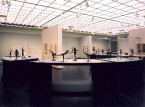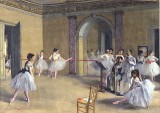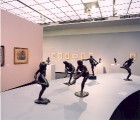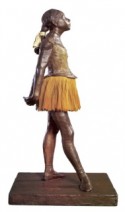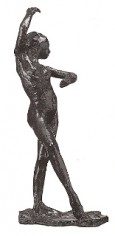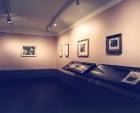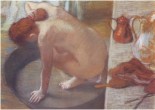The browser will either open the file, download it, or display a dialog.
Edgar Degas: Intimität und Pose
Introduction by Hubertus Gassner, with essays by Werner Hofmann, Pablo Jiménez Burillo, Patrick Bade, Nadia Arroyo Rice, Richard Thomson, Philippe Saunier and William Tucker. München: Hirmer Verlag, 2009.
336 pp; 148 color plates; 50 b/w plates, 60 color ills; 28 b/w ills.; appendices; chronology; bibliography.
€45 (clothbound)
ISBN: 978-3-7774-9035-9
Intimität und Pose (Pose and Intimacy), an exhibition devoted to Edgar Degas' imagery of the female body at the Hamburg Kunsthalle is one of a series of recent shows on the artist. Following a related (differently themed and slightly smaller) exhibition Degas: El Proceso de la Creación (Degas: the Process of Creation) in Madrid at the Fundación MAPFRE it also coincided, entirely coincidentally, with the first major retrospective of the artist in the southern hemisphere: Degas: Master of French Art at the National Gallery of Art, Canberra.
In the wake of the landmark 1988-89 Degas retrospective (Galeries nationales du Grand Palais, Paris; National Gallery of Canada, Ottawa and The Metropolitan Museum of Art, New York) there have been numerous smaller-scale exhibitions of the artist's work relating to various aspects of his practice. Notable here are: Degas: Beyond Impressionism (National Gallery London and Art Institute of Chicago, 1996-7); The Private Collection of Edgar Degas (Metropolitan Museum of Art, 1997-98); Degas at the Races (National Gallery of Art, Washington, 1998); Degas and the Little Dancer (Joslyn Art Museum, Omaha, Nebraska; Sterling and Francine Clark Institute, Williamstown and Baltimore Museum of Art, Baltimore, 1998-99); Degas and the Dance (Detroit Institute of Arts and Philadelphia Museum of Art, 2002-2003) and Degas; Art in the Making (National Gallery, 2004). Providing a range of important new perspectives on Degas's artistic practice and the historical milieu in which it is situated, each of these exhibitions, together with the accompanying publication, made a unique and valuable contribution to the field of Degas scholarship.
The Kunsthalle is well disposed to host an exhibition devoted to one of early modernism's most prominent artists. Home to an important collection of late nineteenth and early-twentieth-century French painting, these holdings were significantly expanded under the directorship of Werner Hofmann, chief curator of the museum between 1969 and 1990. Among this collection are several important works by Degas including the captivating Before the Mirror (1889), which constituted one of the exhibition's centerpieces. Now retired from museum work, Hoffman recently published a substantial monograph on Degas, and maintained an involvement with this exhibition by contributing an essay to the accompanying catalogue (fig. 1).[1] Given the wealth of recent feminist literature relating to Degas's complex imagery of the female body (more on this later), it is perhaps surprising that the Kunsthalle show is the first to deal explicitly with the artist's work relating to this theme, particularly in view of the fact that—in terms of sheer quantity—it far outweighs that of any other subject in his oeuvre. Degas's early forays into history painting and portraiture, together with the equestrian and landscape imagery with which his oeuvre is intermittently punctuated, never came close to contesting the female body as the prevailing motif.
The exhibition certainly brought together a fascinating array of works on this subject. On display in the temporary exhibition wing of the Kunsthalle were almost one hundred and fifty works by the artist, spanning the breadth of his six-decade-long career. The diverse range of media in which Degas practiced was well represented in this exhibition. Pastels, drawings, monotypes, lithographs, aquatints, and the odd painting on loan from a range of public and private collections across the globe were gathered here, together with the complete set of bronze casts made of the wax sculptures salvaged from the artist's studio after his death.
As the works in the exhibition so compellingly testify, the female form was one that Degas was never to tire of representing. Depicted in an ever more bewildering array of poses and scenarios, this was a body subjected to an endless and obsessive reworking over the course of the artist's life. In order to impose some kind of coherence on the proliferation of imagery relating to the female figure constituting the exhibition, the curators categorized the work according to a range of sub-genres in which this oeuvre can loosely be classified, namely: Dancers; Toilette Scenes; and Stage and Brothel. While the exhibition followed a broadly chronological trajectory, these categories endeavored to provide a solid thematic ground through which one could meaningfully navigate this large exhibition.
There were, however, some rather confusing inclusions within the overall layout of the exhibition. This was the case with the first section of the show 'Early Studies', which consisted of a series of early drawings displayed along the left hand wall of the central exhibition space (figs. 2 and 3). Depicting a series of naked female figures in postures of abandon, bondage and distress, they are primarily preparatory figure studies relating to an early history painting: Scene of War in the Middle Ages (1865) (fig. 4) (although no indication of this was given in the wall captions or accompanying brochure). These finely studied drawings, académies to be precise, form part of a group of early works on paper housed in the Cabinet des Dessins at the Louvre, a little known, but no less stunning, corpus which bears out the extent to which Degas's artistic practice was initially mired in the academic classical tradition. This was a set of figurative rhetorics with which the artist was to re-engage later in his career; embedded in Degas's first studies of the female form are a series of poses and figurative motifs which re-emerge in the late nudes. The formal dialogues and affinities at stake between the artist's 'early' and 'late' work is an unexplored seam of Degas's oeuvre. Although the display comprising the first section of the exhibition served to highlight the fact that the artist's overriding preoccupation with the female form is one that can be traced right back to the very beginning of his career, the curatorial selection of these early studies, and the lack of interpretative context, did not, unfortunately, function to draw out the specificity of these connections in any meaningful way.
In any case, the early studies occupied a somewhat marginal place within the main exhibition where they were hung, a space given over to the exhibition's central focus: Degas's work relating to the figure of the ballerina (fig. 5). During his lifetime, Degas was known as 'the painter of dancers', an epithet earned over the course of the 1870s and 1880s as a result of the numerous works on this theme he exhibited at the Impressionist exhibitions. Exemplary of such works is the Musée d'Orsay's The Dance Foyer of the Rue Le Peletier Opera (1872) in which a gaggle of pubescent ballerinas dressed in tutus and pink satin ballet slippers practice their moves under the close watch of the dance master (fig. 6). Due to the legibility of their historically specific interior settings, such imagery is often read as documentary realism; unmediated 'slices' of nineteenth-century life. While Degas certainly had first-hand knowledge of the behind-the-scenes world of the Paris Opéra, these works were not made in situ, but are carefully thought out studio compositions. Observing the dancers at close quarters in the rehearsal room as they went about their daily routine, Degas would execute a series of rough sketches of the various figurative details which caught his eye—a dancer tying the ribbons of her ballet pumps, warming up at the barre, adjusting the strap of her costume, or flexing her legs—before retiring to the studio to refine these poses and assemble his canvases piecemeal from them. There were a considerable number of such studies drawn from life on display here, most of which were situated in close proximity to the larger and more complex pastel drawings and paintings to which they relate. Enabling the spectator to trace the origins of a particular pose or gesture back to the drawing board, they also afforded an important insight into Degas's working methods by revealing the bewildering amount of thought and preparation which went into these multi-figured ballet compositions, as well as the close scrutiny to which the various minutiae of the dancer's poses were subjected under the artist's probing gaze.
The exhibition also took into account the significance of Degas's sculptural work relating to the figure of the dancer (fig. 7). Together with the Little Dancer Aged Fourteen (1881) (the only sculpture Degas exhibited during his lifetime), on display here were myriad smaller bronze figurines illustrating a range of carefully observed balletic poses (figs. 8 and 9). These latter models were never intended for sale or public display. Their purpose was, as Degas himself explained to the critic François Thiébault-Sisson "…to give his paintings and drawings greater expression, greater ardor and more life."[2] The ways in which Degas' three-dimensional artistic practice fed into his picture making was drawn out well by the exhibition in an arrangement which allowed the complex range of formal dialogues at stake between the artist's imagery of the dancer to emerge. This presentation was also entirely in keeping with the circuitous and serial nature of Degas's artistic practice, whose hermetic economy of pictorial means is particularly pronounced in his work on the theme of the ballet, where certain motifs and configurations crop up time and time again, reappearing in endless guises and permutations. The exhibition presented a rare opportunity to see Degas's sculptural work alongside the paintings and drawings to which it relates. There was, however, something rather turgid about these little bronze figures, which were utterly devoid of the liveliness and vivacity characterizing the artist's graphic work relating to the ballet. Although a valuable record of Degas's sculptural practice, memorializing these works in bronze confers upon them a monumentality that is entirely at odds with the purpose for which they were first created. Originally modeled in malleable, but perishable materials such as wax, clay and plastiline, much of the dynamism and vitality these figures must have once possessed has been lost through the casting process and caused them to take on something of the appearance of relics.
To the left of the main hall was the second section of the exhibition: 'Stage and Brothel', a room devoted to Degas' depictions of the brothel and café-concert that probe the seamier side of nineteenth-century Parisian life (fig. 10). While such scenes figure prominently in the artist's work of the late 1870s and 1880s, this was a somewhat tenuous category under which to classify what appeared to be a rather arbitrary selection of works, and one that certainly did not serve to bind this disparate set of images together in any coherent way. However, this did nothing to diminish the extraordinary nature of the works themselves, and contained in this intimate side-gallery were some of the exhibition's main highlights.
Prominent here was the aforementioned Before the Mirror (visible on back wall in fig. 10) in which a young girl seated at a dressing table wearing an ostentatious hat decorated with flowers attaches a hair piece to the back of her head. Datable to around 1889, this is a curiously hybrid image which relates to both the artist's work on the theme of millinery while pre-empting the contemporaneous toilette scenes which the spectator would soon encounter in the next room. Although no such link was made in this exhibition, this picture can be seen to form part of a narrative continuum depicting successive preparations of the toilette, of which the Musée d'Orsay's The Tub is also a part (fig. 11). The female figure's auburn hair, and coincidence of pictorial detail on the dressing table in both images, would certainly seem to bear out this connection.
Also notable here were the so-called 'brothel monotypes' acquired by Picasso in the late 1950s, and now the property of the Musée Picasso, Paris, from whom they were on temporary loan. A form of printmaking where the entire plate is inked, and the image created by then removing the ink, Degas exploited the properties of the monotype to his own advantage. While ink is conventionally removed with brushes to create a 'clean' line in the monotype process, the often blurred and smudgy effects of Degas's brothel imagery was achieved by the use of less precise instruments such as rags and, on occasion, the artist's own fingers. Emerging from these inky surfaces are a series of claustrophobic interior spaces which map onto contemporaneous imagery of brothels by illustrators such as Jean-Louis Forain and Constantin Guys that were widely circulated in nineteenth-century visual culture.[3] Indeed, the sexual and economic transactions taking place within would certainly seem to refer to the inner workings of a maison close. Depicted here are various scenes of client selection where various groups of semi-naked women dressed in stockings, corsets and high heels line long sofas for the perusal of the besuited male figures that lurk ominously at the margins of the picture surface. Despite the graphic inventiveness of these incisive vignettes, there is not much that can be said in defense of the way in which femininity is depicted here. Reduced to a series of brutalized caricatures, it would be counter-intuitive to read these de-individualized female figures as representing anything other than irredeemably debased objects of commercial sexual exchange.
The brothel monotypes might here be seen to shed light on the subtle, but nevertheless insistent, debasement of the feminine that underwrites much of the artist's imagery of the female body. If the beginnings of this tendency were hinted at in the early studies for Scene of War which the spectator encountered at the entrance to the show, it was one which was also present in the awkward bodily syntax and indecorous posturing of Degas's late nudes which comprised the fourth section of the exhibition: Toilette Scenes. The artist's re-engagement with the genre of the nude is marked by his submission to the final Impressionist exhibition in 1886; a group of large pastel bathers depicted attending to various stages of their bodily ablutions, two of which: Woman Drying Her Left Foot and The Tub, were on display in the exhibition. Of all the extensive discourse generated by the Suite of Nudes, the most resonant is still the scathing commentary of Degas's contemporary, the writer and critic Joris-Karl Huysmans. His highly charged visceral descriptions of these contorted figures, bent and twisted into unnatural positions has set the tone through which Degas' imagery of the female body would subsequently come to be read. Indeed, the disparaging terms through which Huysmans conceived of the representation of femininity in the Suite of Nudes has become so firmly entrenched within the discourse on the artist that it is all but impossible to distinguish between the inherent debasement of the female body at stake in the imagery of which he speaks and the virulent metaphors of his own writing. Regarding these images first hand, however, one becomes increasingly aware of a palpable sensuousness to these pictures that Huysmans's misogynistic reading fails to account for. The velvety textures of these images hold a strong tactile appeal, but there are also tantalizing plays of surface within the images themselves, upon which the viewer's gaze is invited to fall; a fleecy white towel, a sumptuously patterned velvet armchair, the shiny surface of a copper kettle, or an unfurling tendril of auburn hair. Moreover, the solicitousness with which these female figures are depicted attending to their ablutions belies 'the attentive cruelty and patient hatred' Huysmans's attributed to Degas in his discussion of this imagery.[4] While the sensorial elements of the imagery prevent me from writing them off as purely 'misogynistic', they only serve to compound the problems that these images raise for feminist-informed spectatorship.
As a sustained attempt to work through the outmoded idealized rhetoric of the female body enshrined in the time-honored genre of the nude, and to update it in relation to a contemporary context, the 1886 Suite of Nudes must surely count as some of the most innovative imagery constituting late nineteenth-century artistic production. Of his re-engagement with the nude in later life, Degas commented dryly: "Two centuries ago I would have painted Susannah at her Bath. Now I just paint a woman bathing".[5]
For all the modernity of these figures, this comment reveals how Degas always understood them to be situated within the representational tradition of the nude. The Suite of Nudes can here be understood as the beginning of a return to the language of classicism that he had been obliged to renounce several decades earlier in pursuit of a visual idiom through which the conditions of experience constituting modern life might be more appropriately articulated.
Indeed, over the course of the late 1880s and 1890s, the artist gradually abandoned the modern life scenarios and contemporary settings with which he had established his reputation at the Impressionist exhibitions to focus almost exclusively upon the sight of the female figure. This transition was vividly illustrated by the later works on display in the exhibition. Although semblances of historically specific domestic interior spaces still remain in Degas's pastel nudes of the late 1880s and early 1900s, they become progressively less naturalistic. Bathtubs loom larger, curtain drapes become heavier, and wallpaper patterns more frenzied. The muted color schemes of the mid-1800s also give way to an altogether more intense palette, consisting of lush greens, deep violets, shocking pinks and flashes of ultramarine. The artist's pastel technique also underwent a substantial transformation over these years; the precisely demarcated figures and carefully hatched forms of the earlier bathers replaced by a more frenetic covering of surface peppered with eruptions of scribbles, scorings and curlicues. While the loss of graphic precision in the late bathers is partly due to the artist's rapidly deteriorating eyesight, the result is an extraordinary intensification of pictorial affect. The late nudes also take on a curious monumentality. Awkwardly clambering in and out of tubs, sponging the backs of their necks or awkwardly drying themselves with huge sheets invoking classical drapery, these ablutionary postures constitute the limited figurative repertoire to which the artist ultimately confined his practice.
Exhibited alongside Degas's two-dimensional imagery of the bathers were examples of his sculptural work on this theme, including a detailed model of a female figure reclining in a shallow tub, and two studies illustrating a female figure balancing on a chair to dry her legs. Although these works constitute a series of interesting sculptural experiments, there is, as Richard Thomson aptly puts it in his catalogue essay, something "lumpen" about these petrified bronze figures, which like the dancer figurines are utterly lacking the lambency of the artist's graphic work.
The final section of the exhibition consisted of a room devoted to Degas's work on the horse and rider. On display here were numerous preparatory studies relating to the artist's racetrack imagery of the 1870s, together with several bronze casts of horses in various poses. The beautifully studied drawings of a horse in motion one encountered here revealed that the artist's keen sensitivity for bodily expressivity was not limited to the human figure. However, given that the explicitly stated theme of the exhibition was Degas's imagery of the female body, these works seemed a rather perplexing aside. The inconsistency of the final room in relation to the rest of the exhibition was compounded by the fact that this imagery was inexplicably interspersed with a series of land and seascapes of the Normandy coastline from the late 1860s.
A beautifully designed hardbound catalogue accompanied the exhibition. Contained within were a series of catalogue essays by both prominent Degas scholars and curators involved with the German and Spanish versions of the show. These were followed by high quality, full-page color illustrations documenting each work in the exhibition as well as a series of appendices: a German translation of the memoir of Degas's model Alice Michel's first published shortly after the artist's death in Mercure de France; a detailed chronology of the artist and a comprehensive bibliography. Unfortunately the catalogue has only been published in German, which will surely do much do hinder its accessibility for much of the Degas scholarly community. Having said that, many of the essays in the catalogue were translations of already published essays or referenced larger research projects on the artist easily available in English.
Although providing a solid informative context for the works on display in the exhibition, the catalogue did not break new historical or interpretative ground. For those already au fait with the artist and his work, there was not much in the way of new, or original, scholarly insight. The catalogue opens with Werner Hofmann's essay "Ein Mann im Abseits" ('A Man Apart').[6] Arguing that Degas's brand of Realism was more trenchant and penetrating than those of his Impressionist colleagues, Hofmann posits him as a superior artistic subject: a "man apart." The second catalogue essay by Spanish curator, Pablo Jiménez Burillo, on the artist's creative process proceeds along the same lines. Although offering some interesting observations on this subject, the essay claimed that, by virtue of his "outsider" status, Degas had a privileged and unique perspective on the conditions of modernity. Although Degas was a singularly innovative practitioner, this pair of essays neglected to take into account the ways in which his practice is embedded within the social, historical, gendered, and economic codes of late nineteenth-century French society, and in doing so only reaffirmed outmoded clichés of artistic creativity and genius.
Of all the catalogue essays, the most insightful was Richard Thomson's "Degas. Sequenzen und Wiederholungen (1880-1910)" (Degas: Sequences and Echoes). Describing the artist's encounter with the Spanish masters during a visit to the Prado at the age of fifty-five, the essay draws attention to the fact that Degas's engagement with the art of the past was not limited to his early academic training, but something that he was to maintain throughout his life. Thomson compares two nude studies of the female torso made around the time of his visit to Madrid with the Prado's Adam and Eve by Titian. While Degas's oeuvre is saturated with motifs and references to past pictorial precedents, he also took a keen interest in the work of his contemporaries. Here the essay proposes a connection between Degas's Little Dancer and another contemporary image of an adolescent female, James Abbot MacNeill Whistler's Harmony in Grey and Green (Portrait of Miss Cicely Alexander) (1872-4), which the artist had seen on a visit to London a few years previously. By situating Degas in dialogue with his artistic forebears and contemporaries, Thomson's essay goes some way towards remedying the misconception put forward by the first two catalogue essays that the artist was somehow operating "apart" from, or "outside" of the dominant visual representational codes of the day. Having said that, it must be noted that one of Degas's most important and profound artistic dialogues throughout his life was with himself. This was also brought to the fore in Thomson's essay through his illuminating discussion of Degas's deployment of seriality and repetition as pictorial strategies that were, as we have seen, particularly pronounced in the artist's late work on the theme of the ballet. The author makes an analogy between the repetitions in Degas's oeuvre and those of the dancer, who must practice her moves over and over again in order to perfect her choreography (in French répétition means ballet rehearsal). It was the pursuit of a similar refinement which motivated Degas's late practice on this subject where endless studies of the same pose or gesture are to be found.
Other essays in the catalogue dealt with particular aspects of the artist's oeuvre covered in the exhibition. An essay by Patrick Bade dealt with Degas's imagery of brothels and café-concerts; another by Nadia Arroyo Rice discussed the critical outcry generated by the Little Dancer when it was first exhibited in 1881. Also included was a translation of a 1973 essay by William Tucker on Degas's sculptural practice.
The theme of this recent Degas exhibition at the Hamburg Kunsthalle was, as stated in the accompanying brochure, the artist's "unique" perspective on the female body. As an exhibition devoted exclusively to these representations, the Kunsthalle show may have been the first of its kind. But, as mentioned at the start of this review, it is precisely this aspect of Degas's oeuvre that has received by far the bulk of attention in the recent literature on the artist. One of the major drawbacks of this exhibition was its failure to acknowledge important feminist scholarship on this subject over the course of the last two decades. Art historians such as Carol Armstrong, Charles Bernheimer, Anthea Callen, Linda Nochlin and Griselda Pollock (to name a few) have unmasked the problematic sexual politics and patriarchal power relations encoded in Degas's imagery of the female body, and demonstrated how his artistic practice is implicated in the representational conventions of late nineteenth-century scientific and social discourse.[7] While this writing has done much to rejuvenate art historical scholarship on the artist, the curators preferred to take the artist at his word. By way of an interpretative context for Degas's depictions of women contained in the exhibition, the brochure handed to the visitor at the entrance to the show opened with the following statement by the artist: "Hitherto the nude has always been represented in poses which presuppose an audience. But my women are simple, honest creatures who are concerned with nothing beyond their physical occupations. It is as if you were looking through a keyhole''. The notion that—due to the intimate nature of the activities in which Degas's female figures are seen to engage—the artist's imagery of this body is "natural" and unmediated, is one of the most damaging fallacies which has accrued itself to his practice. Apart from anything else, the substantial amount of preparatory work on display in the exhibition demonstrated the extent to which Degas's work on this subject was thought out and premeditated. As radical as his interventions into the nude might be, his imagery of the female body is still deeply embedded in both the rhetoric of this historical genre and the prevailing representational codes of late nineteenth-century French society, and cannot be understood apart from these conventions. Although Degas's nudes are far removed from idealized academic rhetoric, to see his female figures as merely "simple, honest, creatures" is to fail to understand the ways in which the female body is objectified, eroticized and sexualized in this imagery, and to remain blind to the sexual politics of spectatorship and voyeuristic viewing conditions inscribed in these "keyhole" scenarios. While one might have been justified in thinking that such simplistic interpretations of the artist's representations of the female body had been unequivocally put to rest by the pioneering feminist scholarship of the last two decades, it was extremely disappointing that such a high profile exhibition did not seek to provide a more critical perspective on this imagery.
Pose and Intimacy was a well thought out and well presented exhibition, which generally provided a coherent synthesis of a diverse range of important works relating to Degas's imagery of the female body. In a presentation which did so much to foreground the breathtaking formal inventiveness and graphic economy of Degas's artistic practice, it was a shame that the show failed adequately to address the deeply problematic nature of this complex body of confounding imagery that is, by turns, both seductive and disturbing.
Philippa Kaina
Teaching Fellow
University College London
[1] Werner Hofmann, Degas: A Dialogue of Difference (London: Thames and Hudson, 1997).
[2] Richard Kendall, Degas by Himself (London: Macdonald and Co, 1987), 246.
[3] See Charles Bernheimer 'Degas's Brothels: Voyeurism and Ideology' in Figures of Ill Repute: Representing Prostitution in Nineteenth-Century France (Cambridge, Mass. and London: Harvard University Press, 1989), 157-199.
[4] Joris-Karl Huysmans, Certains (Paris, 1975), 274.
[5] Daniel Halévy, Degas Parle (Geneva: La Palatine, 1960), 233.
[6] A condensed version of this text forms the first chapter of Hofmann, Degas.
[7] See particularly, Carol Armstrong, Odd Man Out (Chicago: University of Chicago Press, 1991); Charles Bernheimer, 'Voyeurism and Idology'; Anthea Callen, The Spectacular Body: Science, Method and Meaning in the Work of Degas (New Haven and London: Yale University Press, 1995) and Richard Kendall and Griselda Pollock, (eds.) Dealing with Degas: Representations of Women and the Politics of Vision, (New York: Universe, 1991).






